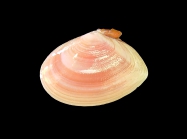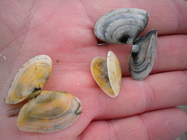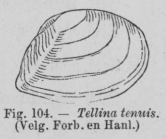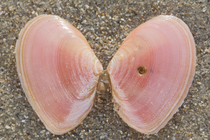WoRMS name details
Tellina tenuis da Costa, 1778
141595 (urn:lsid:marinespecies.org:taxname:141595)
unaccepted
Species
Tellina exigua var. alba O. G. Costa, 1830 · unaccepted > junior subjective synonym
Tellina exigua var. flavescens O. G. Costa, 1830 · unaccepted > junior subjective synonym
Tellina tenuis var. aita De Gregorio, 1885 · unaccepted (synonym)
Tellina tenuis var. brevior Bucquoy, Dautzenberg & Dollfus, 1886 · unaccepted (synonym)
Tellina tenuis var. browni De Gregorio, 1885 · unaccepted (synonym)
Tellina tenuis var. jeffreysi De Gregorio, 1885 · unaccepted (synonym)
Tellina tenuis var. maxima Bucquoy, Dautzenberg & Dollfus, 1886 · unaccepted (synonym)
Tellina tenuis var. minuta Bucquoy, Dautzenberg & Dollfus, 1886 · unaccepted (synonym)
- Variety Tellina tenuis var. aita De Gregorio, 1885 accepted as Tellina tenuis da Costa, 1778 accepted as Macomangulus tenuis (da Costa, 1778) (synonym)
- Variety Tellina tenuis var. angusta R. A. Philippi, 1836 accepted as Macomangulus tenuis (da Costa, 1778) (unaccepted > junior subjective synonym)
- Variety Tellina tenuis var. brevior Bucquoy, Dautzenberg & Dollfus, 1886 accepted as Tellina tenuis da Costa, 1778 accepted as Macomangulus tenuis (da Costa, 1778) (synonym)
- Variety Tellina tenuis var. browni De Gregorio, 1885 accepted as Tellina tenuis da Costa, 1778 accepted as Macomangulus tenuis (da Costa, 1778) (synonym)
- Variety Tellina tenuis var. jeffreysi De Gregorio, 1885 accepted as Tellina tenuis da Costa, 1778 accepted as Macomangulus tenuis (da Costa, 1778) (synonym)
- Variety Tellina tenuis var. maxima Bucquoy, Dautzenberg & Dollfus, 1886 accepted as Tellina tenuis da Costa, 1778 accepted as Macomangulus tenuis (da Costa, 1778) (synonym)
- Variety Tellina tenuis var. minuta Bucquoy, Dautzenberg & Dollfus, 1886 accepted as Tellina tenuis da Costa, 1778 accepted as Macomangulus tenuis (da Costa, 1778) (synonym)
marine
Da Costa, E. M. (1778). <i>Historia naturalis testaceorum Britanniæ, or, the British conchology</i>; containing the descriptions and other particulars of natural history of the shells of Great Britain and Ireland: illustrated with figures. In English and French. - Historia naturalis testaceorum Britanniæ, ou, la conchologie Britannique; contenant les descriptions & autres particularités d'histoire naturelle des coquilles de la Grande Bretagne & de l'Irlande: avec figures en taille douce. En anglois & françois. i-xii, 1-254, i-vii, [1], Pl. I-XVII. London. (Millan, White, Emsley & Robson). , available online at https://www.biodiversitylibrary.org/page/13116783
page(s): 210-211 [details]
page(s): 210-211 [details]
Note not stated [British Isles]
Type locality not stated [British Isles] [details]
Description A thin, strongly flattened shell with an irregular oval shape. Front edge broadly rounded, back edge
tapering in a clear...
Distribution Tellina tenuis was found in both periods in the western near-coastal zone. In addition, the species was also observed in...
Distribution T. tenuis does not occur in the offshore parts of the North Sea, but is restricted to a narrow zone along the coast, the...
tapering in a clear...
Description A thin, strongly flattened shell with an irregular oval shape. Front edge broadly rounded, back edge
tapering in a clear angle. The back is somewhat less acuminate than in the Tellina fabula. The shell surface is practically smooth with only fine growth lines. Measures up to 30 mm long. The colour varies from white with dark colour bands to pinkish red. [details]
tapering in a clear angle. The back is somewhat less acuminate than in the Tellina fabula. The shell surface is practically smooth with only fine growth lines. Measures up to 30 mm long. The colour varies from white with dark colour bands to pinkish red. [details]
Distribution Tellina tenuis was found in both periods in the western near-coastal zone. In addition, the species was also observed in...
Distribution Tellina tenuis was found in both periods in the western near-coastal zone. In addition, the species was also observed in the area of the Hinder Banks, but only in the 1994-2001 period. The frequency of occurrence in both periods was relatively low and the species never reached high density levels (maximum 30 ind./m2). [details]
Distribution T. tenuis does not occur in the offshore parts of the North Sea, but is restricted to a narrow zone along the coast, the...
Distribution T. tenuis does not occur in the offshore parts of the North Sea, but is restricted to a narrow zone along the coast, the Wadden Sea, the Oosterschelde and part of the Westerschelde. [details]
MolluscaBase eds. (2024). MolluscaBase. Tellina tenuis da Costa, 1778. Accessed through: World Register of Marine Species at: https://www.marinespecies.org/aphia.php?p=taxdetails&id=141595 on 2024-09-25
Date
action
by
![]() The webpage text is licensed under a Creative Commons Attribution 4.0 License
The webpage text is licensed under a Creative Commons Attribution 4.0 License
original description
Da Costa, E. M. (1778). <i>Historia naturalis testaceorum Britanniæ, or, the British conchology</i>; containing the descriptions and other particulars of natural history of the shells of Great Britain and Ireland: illustrated with figures. In English and French. - Historia naturalis testaceorum Britanniæ, ou, la conchologie Britannique; contenant les descriptions & autres particularités d'histoire naturelle des coquilles de la Grande Bretagne & de l'Irlande: avec figures en taille douce. En anglois & françois. i-xii, 1-254, i-vii, [1], Pl. I-XVII. London. (Millan, White, Emsley & Robson). , available online at https://www.biodiversitylibrary.org/page/13116783
page(s): 210-211 [details]
context source (Schelde) van Zweeden, C.; van Asch, M.; van den Ende, D.; Troost, K. (2013). Het kokkelbestand in de Nederlandse kustwateren in 2013. <em>IMARES Wageningen Report, C115/13. IMARES Wageningen UR: IJmuiden.</em> 46 pp. (look up in IMIS) [details]
basis of record Gofas, S.; Le Renard, J.; Bouchet, P. (2001). Mollusca. in: Costello, M.J. et al. (eds), European Register of Marine Species: a check-list of the marine species in Europe and a bibliography of guides to their identification. <em>Patrimoines Naturels.</em> 50: 180-213., available online at http://www.vliz.be/imisdocs/publications/ocrd/254404.pdf [details]
additional source Zamouri-Langar, N.; Chouba, L.; Ajjabi Chebil, L.; Mrabet, R.; El Abed, A. (2011). Les coquillages bivalves des côtes tunisiennes. Institut National des Sciences et Technologies de la Mer: Salammbô. ISBN 978-9938-9512-0-2. 128 pp. (look up in IMIS) [details]
page(s): 210-211 [details]
context source (Schelde) van Zweeden, C.; van Asch, M.; van den Ende, D.; Troost, K. (2013). Het kokkelbestand in de Nederlandse kustwateren in 2013. <em>IMARES Wageningen Report, C115/13. IMARES Wageningen UR: IJmuiden.</em> 46 pp. (look up in IMIS) [details]
basis of record Gofas, S.; Le Renard, J.; Bouchet, P. (2001). Mollusca. in: Costello, M.J. et al. (eds), European Register of Marine Species: a check-list of the marine species in Europe and a bibliography of guides to their identification. <em>Patrimoines Naturels.</em> 50: 180-213., available online at http://www.vliz.be/imisdocs/publications/ocrd/254404.pdf [details]
additional source Zamouri-Langar, N.; Chouba, L.; Ajjabi Chebil, L.; Mrabet, R.; El Abed, A. (2011). Les coquillages bivalves des côtes tunisiennes. Institut National des Sciences et Technologies de la Mer: Salammbô. ISBN 978-9938-9512-0-2. 128 pp. (look up in IMIS) [details]
 Present
Present  Present in aphia/obis/gbif/idigbio
Present in aphia/obis/gbif/idigbio  Inaccurate
Inaccurate  Introduced: alien
Introduced: alien  Containing type locality
Containing type locality
From editor or global species database
Type locality not stated [British Isles] [details]From other sources
Biology Spawning occurs in June-August. T. tenuis most probably has a pelagic larval stage. Longevity is reported to be about five years. The species usually lies on the left valve, a few centimetres below the sediment-surface. its burrowing depth depends on the tide and exceeds 10 cm at low tide (Tebble, 1966; Wolff, 1973; Fish & Fish, 1989). T. tenuis is a suspension feeder with tendencies to selective deposit-feeding. lt takes vegetable detritus, but diatoms may also occur in the gut. Young flatfish often feed on the tips of the protruding siphons, which are subsequently regenerated (Wolff, 1973; Fish & Fish, 1989). T tenuis is sensitive to low winter temperatures and therefore shows low nurnbers after cold winters (Beukerna, 1979; Beukema & Essink, 1986). [details]
Description A thin, strongly flattened shell with an irregular oval shape. Front edge broadly rounded, back edge
tapering in a clear angle. The back is somewhat less acuminate than in the Tellina fabula. The shell surface is practically smooth with only fine growth lines. Measures up to 30 mm long. The colour varies from white with dark colour bands to pinkish red. [details]
Distribution Tellina tenuis was found in both periods in the western near-coastal zone. In addition, the species was also observed in the area of the Hinder Banks, but only in the 1994-2001 period. The frequency of occurrence in both periods was relatively low and the species never reached high density levels (maximum 30 ind./m2). [details]
Distribution T. tenuis does not occur in the offshore parts of the North Sea, but is restricted to a narrow zone along the coast, the Wadden Sea, the Oosterschelde and part of the Westerschelde. [details]
Habitat Tellina tenuis occurs in a wide range of sediments: median grain size of 150 to 500 μm. The main restrictive factor appears to be the mud content: the species only occurs in sediments with a mud content < 20%. The relative occurrence of 10% in sediments with a mud content of 40-50% is considered an outlier and hence seen as unreliable. [details]
Habitat T. tenuis generale inhabits fine, clean sand, with low percentages of silt. [details]
Morphology A brittle, somewhat flattened shell. The right valve is slightly larger than the left one. lt is nearly oval in outline and measures up to 25 mm in length. The shell is covered with fine concentric lines. The growth stages are clear. The colour is very variable, including white, shades of pink, yellow, and orange, often arranged in distinct bands. The inside of the shell is coloured like the outside, but normally fainter (Tebble, 1966; Fish & Fish, 1989; Hayward & Ryland, 1990). [details]
| Language | Name | |
|---|---|---|
| Danish | almindelig tallerkenmusling | [details] |
| Dutch | tere platschelptere dunschaal | [details] |
| English | thin tellin | [details] |
| French | telline papillontelline mincepapillon | [details] |
| German | platte Tellmuscheldünne Plattmuschel | [details] |
| Modern Greek (1453-) | Τελλινίτσα | [details] |
To Barcode of Life (2 barcodes)
To Biodiversity Heritage Library (290 publications)
To GenBank (671 nucleotides; 3 proteins)
To Marine Bivalves of the British Isles webpage at National Museum of Wales
To PESI
To PESI (from synonym Tellina tenuis var. browni De Gregorio, 1885)
To PESI (from synonym Tellina tenuis var. jeffreysi De Gregorio, 1885)
To PESI (from synonym Tellina tenuis var. aita De Gregorio, 1885)
To PESI (from synonym Tellina tenuis var. maxima Bucquoy, Dautzenberg & Dollfus, 1886)
To PESI (from synonym Tellina tenuis var. brevior Bucquoy, Dautzenberg & Dollfus, 1886)
To PESI (from synonym Tellina tenuis var. minuta Bucquoy, Dautzenberg & Dollfus, 1886)
To PESI (from synonym Tellina exigua var. flavescens O. G. Costa, 1830)
To PESI (from synonym Tellina exigua var. alba O. G. Costa, 1830)
To USNM Invertebrate Zoology Mollusca Collection
To ITIS
To Biodiversity Heritage Library (290 publications)
To GenBank (671 nucleotides; 3 proteins)
To Marine Bivalves of the British Isles webpage at National Museum of Wales
To PESI
To PESI (from synonym Tellina tenuis var. browni De Gregorio, 1885)
To PESI (from synonym Tellina tenuis var. jeffreysi De Gregorio, 1885)
To PESI (from synonym Tellina tenuis var. aita De Gregorio, 1885)
To PESI (from synonym Tellina tenuis var. maxima Bucquoy, Dautzenberg & Dollfus, 1886)
To PESI (from synonym Tellina tenuis var. brevior Bucquoy, Dautzenberg & Dollfus, 1886)
To PESI (from synonym Tellina tenuis var. minuta Bucquoy, Dautzenberg & Dollfus, 1886)
To PESI (from synonym Tellina exigua var. flavescens O. G. Costa, 1830)
To PESI (from synonym Tellina exigua var. alba O. G. Costa, 1830)
To USNM Invertebrate Zoology Mollusca Collection
To ITIS





